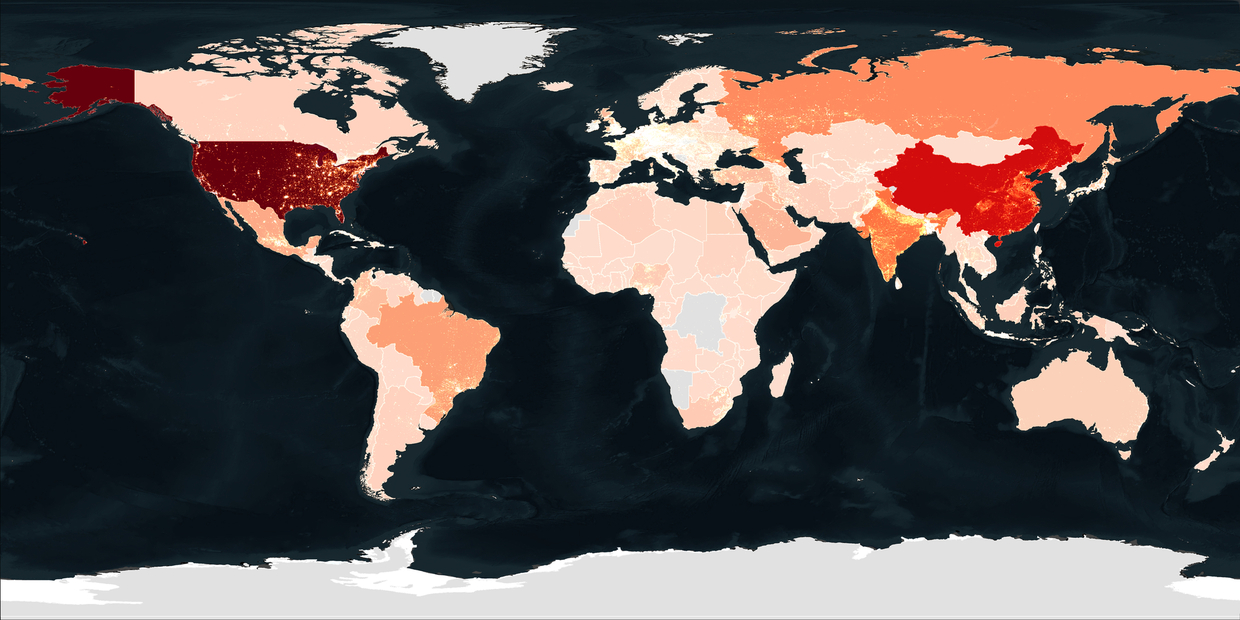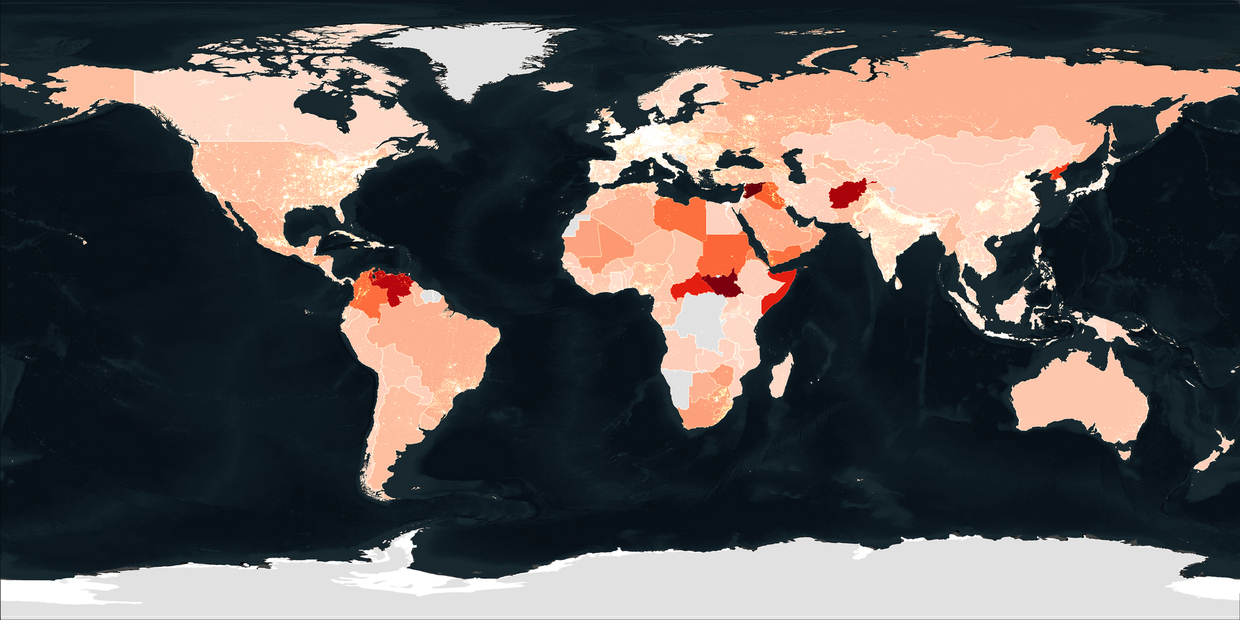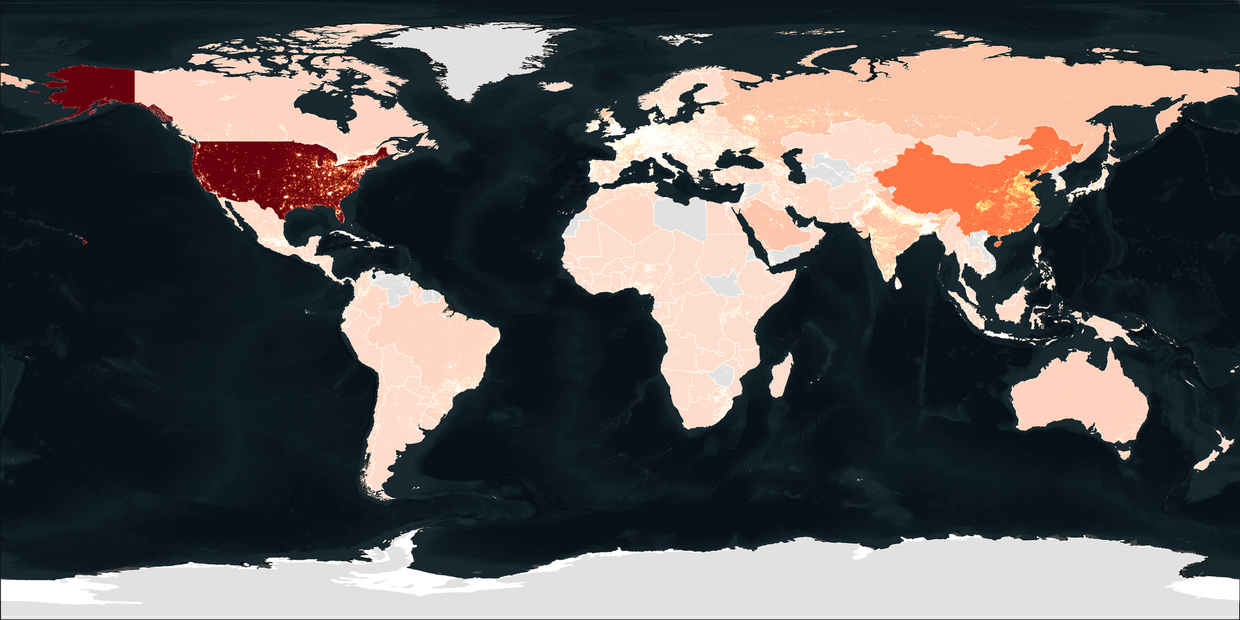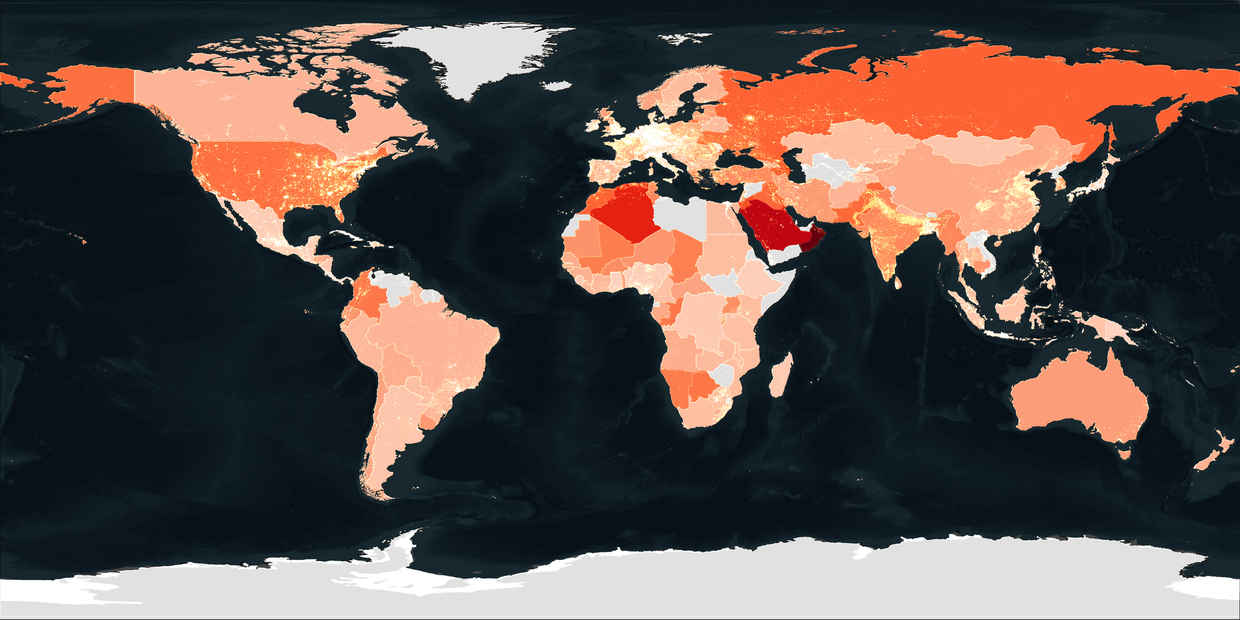Every gun that is made, every warship launched, every rocket fired signifies, in the final sense, a theft from those who hunger and are not fed, those who are cold and are not clothed. This world in arms is not spending money alone. It is spending the sweat of its laborers, the genius of its scientists, the hopes of its children.

Between 1960 and 2021, US military spending increased fifteen fold to $731 billion (and counting).
This planetary militarization extends beyond the surface. From the seafloor to the atmospheric ceiling, the world has been and is being remade by the ballooning presence and power of American militarization. Kristen Simmons reminds us that, during the militarized response to and terrorization of Indigenous-led resistance at Standing Rock: “The atmosphere is increasingly a sphere to be weaponized.”
Funding is the beginning of the military supply matrix. In shades of red, four maps show the spread of relationships between military expenditures, violence, and GDP over a global base map of GDP clusters and existing borders. In raw spending, the US outranks all other nations in both military expenditure and the cost of violence, but when normalized to GDP, other nations rise to the fore. While raw spending shows the flat investment into military supply matrices, percent GDP shows how much an entire economy of a nation is invested into warfighting. Neither is a preferable relationship. These relationships show just how much capital, labor, and energy could be reallocated away from planetary militarization, and toward climate futures of abundance worth fighting, and living, for.
Ensuring the primacy of planetary militarization is one of the only bipartisan propositions left in the U.S. On May 19th, 2019, in the throes of the 2020 US presidential election primaries and at a time when climate was marked as the top issue for the Democratic nominee in some polls,
Responses to the plan highlighted the well-established hypocrisy of “sustainable militarism,”
Yet in certain spheres of environmental “experts” the plan was celebrated. According to Vox reporting,
[T]he DOD [US Department of Defense] is the world’s largest institutional user of petroleum and correspondingly, the single largest institutional producer of greenhouse gasses (GHG) in the world.
While “expert” voices in environmental politics saw the green military as a competitive advantage, the authors of this project see it as folly. In 2011, General Petraus famously declared “Energy is the lifeblood of our warfighting capabilities.”
This is not the first time climate policy has been co-opted to save militarism. In the mid-2000s, responding to the US war in the Middle East, military consultant Sherri Goodman coined the term “threat multiplier,” a new catch phrase for the Climate Crisis.
Within a decade of being introduced, “threat multiplier” had been embraced by the Obama administration,
[T]he reality is that solar energy, electric vehicles, or aspirations of “carbon neutrality” may promise fuel-efficiency but do nothing to make the U.S. military any less violent or oppressive.
On March 5, 2020, Elizabeth Warren dropped out of the 2020 US presidential election; almost one month later Joe Biden was named the Democratic nominee. While Warren and Biden each had a different framing of why the climate-military nexus is necessary to ensure “victory” over the Climate Crisis, or in the case of President Biden, victory over China, the result of either winning the democratic nomination would have been expanded American militarism under the banner of the Climate Crisis. Biden’s nomination was not the death of the climate-military industrial complex in the battle for Democratic Party leadership—but the inevitable hardening of climate-militarism into the party's climate policy.
President Biden’s particular brand of climate-militarism focuses on a bipartisan-approved enemy: China.
We articulate this concept to show the resilience of the climate-military industrial complex and the industrial capture of American elite politicians. Climate-militarism presents a new front for the fossil fuel led energy-industrial complex and the military-industrial complex to combine their lobbying power, ensuring political capture of both major US political parties. The entrenchment of both House and Senate democrats within the military industrial complex has been extensively documented, finding “when it comes to the US military budget, campaign contributions are a better predictor for how congressional Democrats will vote.”
The Climate Cold War is the more resilient concept of the energy-military crossover event in today’s political climate. Expanding planetary climate-militarism provides political cover for Republicans and Democrats alike to accept energy-military industrial donations that inevitably influence domestic and foreign policy. The political capture of military industrialists and oil and gas lobbyists presents a glaring problem for US climate leadership: how can other nations expect American domestic and foreign climate policies to meaningfully and consistently move towards decarbonization? Even Biden’s campaign plan “for a Clean Energy Revolution and Environmental Justice” writes of “self-interested Chinese projects,” and that the plan will ”pursue strong new measures to stop other countries from cheating on their climate commitments. We can no longer separate trade policy from our climate objectives. Biden will not allow other nations, including China, to game the system.”
The worldbuilding around a US-China Climate Cold War continues with President Biden in office—in the American Jobs Plan,
The Green New Deal must not enact the Climate Cold War. For the Green New Deal to be internationalist, climate politics must not save planetary militarization. This is not to say that threat multiplier or green military are incomplete. It is not a question; the Climate Crisis will rewrite and is rewriting every aspect of relation on the planet from which species survive to which peoples will thrive; institutions must rise to the existential threat. This is a question of auguring a new future—that is, what will decarbonization rescue? What will the Green New Deal save, and what will be cared for into the future? The internationalist Green New Deal is a vision of a future where decarbonization doesn’t just techno-fix climate-military industrial complex supply chains and make them “green”; it is a future where decarbonization challenges the very foundations of settler colonialism, empire, and immiseration that terraformed the Climate Crisis. When you consider the latter definition of decarbonization, green militarism, threat multiplier, and the Climate Cold War are made useless; they are not needed in a future without planetary militarization.
Which future to choose it clear. On one hand, 195 green militaries build green drones that make green drone strikes on climate refugees in theatres of war defined by severe heat or water scarcity. On the other hand, decarbonization leads to global abundance and global climate justice. Decarbonization is a call to augur a future without the architects of the Climate Crisis, and the internationalist Green New Deal is also a call to think a future without the supply matrices of war.
What is over the horizon of decarbonization is yet being formed by movements, artists, writers, and visionaries.







